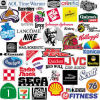 Here’s another belated lunchtime post (can you tell I’m clearing out a backlog). This time, the subject is selling and marketing:
Here’s another belated lunchtime post (can you tell I’m clearing out a backlog). This time, the subject is selling and marketing:
- Working In Retail. Have you ever thought that those folks selling you stuff at the retail level had it easy? Well, that’s not the case. Here are two exposes on the subject. The first was brought to my attention when we visited Portland OR and someone suggested Voodoo Donuts. Evidently, VD is not the nicest place to work. The second I discovered this week — it is the story of a former journalist who got caught in some downsizing, and ended up working retail. He discovered that life at the retail level was nasty, and a place where you were always under suspicion for theft of goods or time. This makes me very glad I’ve never worked retail.
- Working as a Telemarketer. We all get them — the calls from the telemarketer just as you’re sitting down to dinner or about to watch your favorite program. Ever wonder how to get rid of them. Here’s the answer — from a former telemarketer. Very interesting reading.
- Corporate Comings and Goings. Some interesting corporate changes of late. The battle between Jos A Banks and Mens Wearhouse has finally ended: Mens Wearhouse is purchasing Jos A Banks, and Banks is giving up purchasing Eddie Bauer. I’m not sure what to think about this. I liked Banks when I shopped there, but their stuff was expensive. Never shopped Mens Warehouse. In the supermarket arena, Vons / Safeway has been purchased by Albertsons. We no longer shop at the majors (give us TJs, Fresh & Easy, or an ethnic chain), but we were never impressed by Albertsons. It will be interesting to see what they do with Vons. Lastly, Quiznos has filed Chapter 11, and the franchisees are none too happy about it. I’ve never been a Quiznos fan — I’ve always gone to Togos first, with Subway as the distinct second choice (and I’ve never tried Jersey Mikes). However, it doesn’t surprise me — the few times I’ve tried Quiznos, I haven’t been impressed.


 Yesterday was February 1st, and so
Yesterday was February 1st, and so  As I’ve gotten older, I’ve notice that things from my past are fascinating me more and more. Here are a few lunch-time stories about things from my past… plus one intriguing new thing just announced…
As I’ve gotten older, I’ve notice that things from my past are fascinating me more and more. Here are a few lunch-time stories about things from my past… plus one intriguing new thing just announced… Yesterday, I indicated that I wanted to discuss some recent articles in the LA Times concerning gas and gas stations. Well, today’s the day:
Yesterday, I indicated that I wanted to discuss some recent articles in the LA Times concerning gas and gas stations. Well, today’s the day: